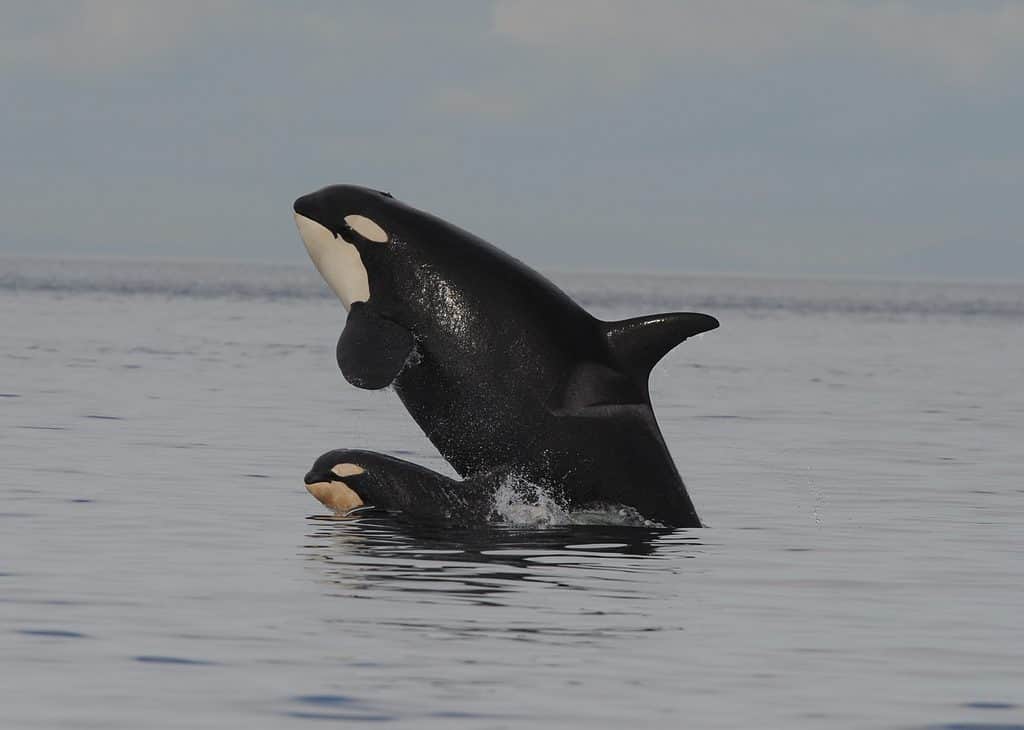
In what seems to be the equivalent of a grown man still living in his mother’s basement, researchers at the University of Exeter have discovered that the same could be occurring in the ocean world. While, it’s not out of the ordinary for parents, and especially mothers, to put their children’s needs ahead of their own in the pursuit of the offspring’s success, a new study published in Current Biology shows that killer whale mothers go to surprising lengths to ensure their young survive. The mothers have even given up having new young to take care of their sons, even when they are adults in their own right.
Killer whale mothers are known to provide more support to sons than daughters, especially after the daughters reach adulthood and are basically reared away, but the extent to which they keep caring for their adult male offspring was surprising. Researchers learned that caring for their adult male offspring is cutting a mother’s annual likelihood of successful breeding (a calf surviving to one year old) by about half.
“We’ve known for over a decade that adult male killer whales relied on their mothers to keep them alive, but it had never been clear whether mothers pay a cost to do so,” said Michael Weiss of the University of Exeter and the Center for Whale Research in the United States.
Weiss and his colleagues studied data from 1982 to 2021 on 40 female killer whales in the coastal waters of Washington state and British Columbia known as the “southern resident” population. Scientists were curious whether there was a fertility cost associated with maternal care for adult whales, particularly males. In-depth demographic data allowed them to examine the link between mothers’ care for their sons and daughters and their fertility rates.
“The southern resident killer whale community presents an incredible opportunity to investigate these kinds of questions,” Weiss said. “Along with their bizarre social system, where both males and females stay with their mom for life, they are also one of the best studied wild populations of mammals anywhere in the world.”
The researchers discovered that the likelihood of a female having a healthy calf each year is inversely proportional to the number of her weaned sons who survive each year. This didn’t change as their sons got older, either.
The southern resident killer whales are fish eaters that primarily consume salmon. Typically, mothers bite salmon in half, eating one half and giving the other half to their sons. They tend to stop feeding their young daughters once they reach reproductive age, whereas they continue to feed their sons into adulthood.
The findings lend credence to the idea that raising sons into adulthood harms reproduction. The researchers say the results reveal an unrecognized life history strategy and provide the first direct evidence for lifetime maternal investment in any animal.
“The magnitude of the cost that females take on to care for their weaned sons was really surprising,” Weiss said. “While there’s some uncertainty, our best estimate is that each additional surviving son cuts a female’s chances of having a new calf in a given year by more than 50 percent. This is a huge cost to taking care of [adult] sons! Females gain evolutionary benefits when their sons are able to successfully reproduce, and our results indicate that these benefits are enough to outweigh a large direct cost.”
The findings may also have significant conservation implications. The population of southern residents are critically endangered, with just 73 residents remaining. Since the southern residents don’t interbreed with other killer whale pods, their low reproductive rates are a major cause for concern.
These new results shed light on a previously unrecognized factor that significantly affects a female’s reproductive success, which could guide population stability studies in the future. So, for a population living on a knife’s edge, the number of females and the reproductive capacity of those females will determine the extent to which the population’s potential for recovery can increase.
“One big take-away is further evidence for how special (and maybe unique) the mother-son bond in killer whales is,” Weiss said. “Maybe more importantly, our study adds to the growing body of work showing the importance of animals’ social systems in determining demographic patterns. This is of central importance both for an understanding of our world, and to effectively conserve endangered species.”
The study was carried out by the universities of Exeter, York and Cambridge and the Center for Whale Research.









